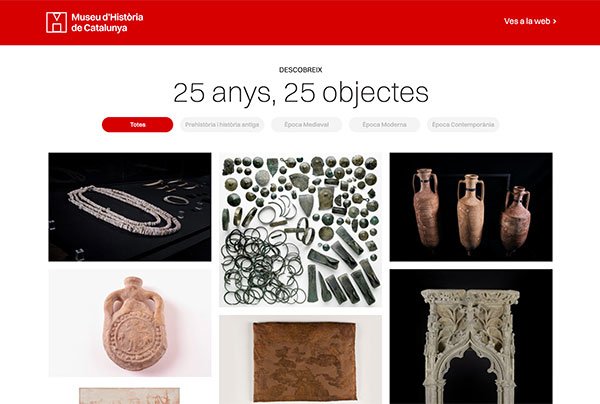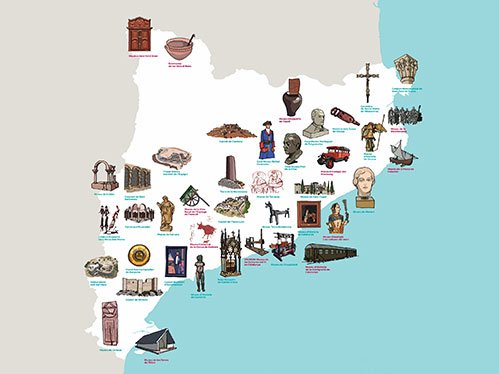Al canviar d'idioma no tots els continguts estan traduïts
The website is not fully translated
Al cambiar de idioma no todos los contenidos están traducidos
Al canviar d'idioma no tots els continguts estan traduïts
 Opening times
Opening times
 Location
Location
 Tickets
Tickets
 Admissions
Admissions
Opening times
Tuesday to Saturday, 10am to 7pm
Wednesdays, 10am to 8pm
Sundays and public holidays, 10am to 2.30pm
The ticket office and entrance are closed 30 minutes before closing time
CLOSED: Mondays that are not bank holidays, 1 and 6 January, 1 May, 18 May, 1 June, 25 and 26 December
Location
Address
Plaça de Pau Vila, 3
08039 Barcelona
Coordinates: 41.380900, 2.185693
Contact
932 254 700
mhc.cultura@gencat.cat
Fax 932 254 758
Group and school bookings:
932 254 244
Monday to Thursday: 10am-2pm and 3.30-5.30pm
Friday: 9.30am-2pm
mhcvisites.cultura@gencat.cat
Transport and access routes
Public transport
Buses V17, H14, D20, V15, V13, 39, 45, 51, 59 and 120
Metro L4 (yellow) Barceloneta
Train to Barcelona Estació de França
Barcelona Tourist Bus: red line; and Barcelona City Tour: eastern route; Museu d’Historia de Catalunya stop.
Parking
There are three paid-for car parks nearby: in Passeig Joan de Borbó, Moll d’Espanya and Moll de la Fusta.
Coaches have parking spaces available near the museum building.
“Bicing” bicycle hire in Plaça Pau Vila.
Admissions
Permanent exhibition
Temporary exhibitions
General admission: 4 euros
Reduced admission: 3 euros
Combined ticket
Permanent exhibition + temporary exhibition
General admission: 8 euros
Reduced admission: 6 euros
 Opening times
Opening times
 Location
Location
 Tickets
Tickets
 Admissions
Admissions
Opening times
Tuesday to Saturday, 10am to 7pm
Wednesdays, 10am to 8pm
Sundays and public holidays, 10am to 2.30pm
The ticket office and entrance are closed 30 minutes before closing time
CLOSED: Mondays that are not bank holidays, 1 and 6 January, 1 May, 18 May, 1 June, 25 and 26 December
Location
Address
Plaça de Pau Vila, 3
08039 Barcelona
Coordinates: 41.380900, 2.185693
Contact
932 254 700
mhc.cultura@gencat.cat
Fax 932 254 758
Group and school bookings:
932 254 244
Monday to Thursday: 10am-2pm and 3.30-5.30pm
Friday: 9.30am-2pm
mhcvisites.cultura@gencat.cat
Transport and access routes
Public transport
Buses V17, H14, D20, V15, V13, 39, 45, 51, 59 and 120
Metro L4 (yellow) Barceloneta
Train to Barcelona Estació de França
Barcelona Tourist Bus: red line; and Barcelona City Tour: eastern route; Museu d’Historia de Catalunya stop.
Parking
There are three paid-for car parks nearby: in Passeig Joan de Borbó, Moll d’Espanya and Moll de la Fusta.
Coaches have parking spaces available near the museum building.
“Bicing” bicycle hire in Plaça Pau Vila.
Admissions
Permanent exhibition
Temporary exhibitions
General admission: 4 euros
Reduced admission: 3 euros
Combined ticket
Permanent exhibition + temporary exhibition
General admission: 8 euros
Reduced admission: 6 euros
Portrait of contemporary Catalonia. From the Transition to the present day
Since 1980, Catalonia has experienced the longest period of self-government in its contemporary history. The democratisation of public life, European integration, the extension of services associated with the Welfare State and the increase in the population, with the arrival of immigrants from all over the world, are among the characteristic features of this period.
With the showing of the audiovisual Cataluña.cat, this area shows a summary of the history of the country from the death of Franco to the present day. The museum also invites visitors to participate in an interactive questionnaire about some key aspects that have marked the evolution of Catalan society in the last few decades.

Older and more diverse
Between 1980 and 2006, the population of Catalonia moved from six to seven million. The demographic stagnation of the eighties gave rise to considerable growth in the subsequent decades – the result of a new wave of migration and an increase in life expectancy. The ageing of the population is considered one of the great challenges of the future.
Catalonia has become a territory with great cultural diversity, with citizens from all over the world. Values and ways of life have been noticeably transformed in recent decades, leading to a more open and tolerant society that incorporates new models of family. One of its greatest assets is respect for diversity and the vitality of civil society.
Catalan: a language for everyone?
After the persecution suffered during Francoism, with the restoration of self-government began a process of revitalising the language. With the complicity of civil society, government initiatives were promoted in favour of Catalan and the Aranese language (the dialect of Occitan spoken in a valley in north-western Catalonia). These included the Catalan Language Normalisation Act (1983) and the Language Policy Act (1998).
The arrival of several waves of migration in the last few decades raises new challenges for the language. According to statistical studies, high percentages of recent arrivals are learning Catalan and increasing numbers of them consider it to be their language. In this context, the language immersion model in the publicly-funded school system represents a success, contributing decisively to social cohesion.
Competitiveness
Since the sixties, the structure of the Catalan economy has been undergoing far-reaching changes. Two great crises in the periods 1975-1984 and 1992-1995 caused the loss of thousands of jobs. The economic model was transformed with the expansion in the service sector to the detriment of agriculture and industry. Tourism became a fundamental sector.
Spain’s entry into the process of European integration in 1986 represented notable progress in the internationalisation of the Catalan economy, as well as a challenge for its competitiveness. Since the nineties, Catalonia has concentrated a quarter of all Spain’s foreign investment, becoming one of the most active and dynamic regions in southern Europe.
The new poverty
Despite the social advances and general modernisation of society, groups of the population still live below the poverty line. Young people with social difficulties, the long-term unemployed and, above all, elderly people as a result of longer life expectancies and low pensions, are the main risk groups.
Recent immigrants without resources are another group that should be highlighted. The increasing cost of living, lack of job security, difficulties in affording housing and limitations to social policies had already become challenges for the Welfare State even before the property bubble burst and the economic crisis began.
Greater autonomy
Political autonomy, governed by the Catalan Statute of Autonomy, allows deeper democracy in the country, with public participation by citizens and the construction of self-government that aspires to all the institutions of an autonomous, democratic and socially advanced society.
Throughout this period, the Generalitat became institutionalised and developed, just like the other public administrations throughout the territory intended to improve all aspects of people’s living conditions: the Welfare State, balancing regional progress and raising the social, cultural, economic and political profile of Catalonia in the world.
More public facilities
The improvement in infrastructures and the network of public facilities has been a constant since the recovery of self-government. All authorities with powers in Catalonia contribute towards it, particularly the Generalitat and the local councils.
Since the mid-eighties, Catalonia has directly managed policy concerning health, education, universities, culture, the media, justice and public safety.
Institutional history
In 1980, the first autonomous government chosen by democratic elections was established, presided over by Jordi Pujol, of the political federation Convergència i Unió. Pujol presided over the Generalitat for five parliamentary terms in a period characterised by the development of autonomy and the institutionalisation of the organs of self-government.
In the Catalan parliamentary elections of 2004, Pasqual Maragall of the Catalan Socialist Party (PSC) was elected President of the Generalitat at the head of a three-party government of left-wing and Catalan nationalist parties, completing the alternation of political power in Catalonia. Two years later, he was succeeded by his fellow socialist José Montilla.
Parliamentary life and results
Since the restoration of self-government, Catalan parliamentary life has revolved around five relatively stable parties: Convergència i Unió (CiU), Partit dels Socialistes de Catalunya (PSC), Partit Popular (PP), Esquerra Republicana de Catalunya (ERC) and Iniciativa per Catalunya Verds-Esquerra Unida i Alternativa (ICV-EUiA).
The presence of an interactive module in this area makes it possible to check all kinds of data related to the operation of the Parliament of Catalonia, from 1980 to the present day.
Opening times
Tuesday to Saturday, 10am to 7pm
Wednesdays, 10am to 8pm
Sundays and public holidays, 10am to 2.30pm
The ticket office and entrance are closed 30 minutes before closing time
CLOSED: Mondays that are not bank holidays, 1 and 6 January, 1 May, 18 May, 1 June, 25 and 26 December
Location
Address
Plaça de Pau Vila, 3
08039 Barcelona
Coordinates: 41.380900, 2.185693
Contact
932 254 700
mhc.cultura@gencat.cat
Fax 932 254 758
Group and school bookings:
932 254 244
Monday to Thursday: 10am-2pm and 3.30-5.30pm
Friday: 9.30am-2pm
mhcvisites.cultura@gencat.cat
Transport and access routes
Public transport
Buses V17, H14, D20, V15, V13, 39, 45, 51, 59 and 120
Metro L4 (yellow) Barceloneta
Train to Barcelona Estació de França
Barcelona Tourist Bus: red line; and Barcelona City Tour: eastern route; Museu d’Historia de Catalunya stop.
Parking
There are three paid-for car parks nearby: in Passeig Joan de Borbó, Moll d’Espanya and Moll de la Fusta.
Coaches have parking spaces available near the museum building.
“Bicing” bicycle hire in Plaça Pau Vila.
Admissions
Permanent exhibition
Temporary exhibitions
General admission: 4 euros
Reduced admission: 3 euros
Combined ticket
Permanent exhibition + temporary exhibition
General admission: 8 euros
Reduced admission: 6 euros




 Twitter
Twitter Facebook
Facebook